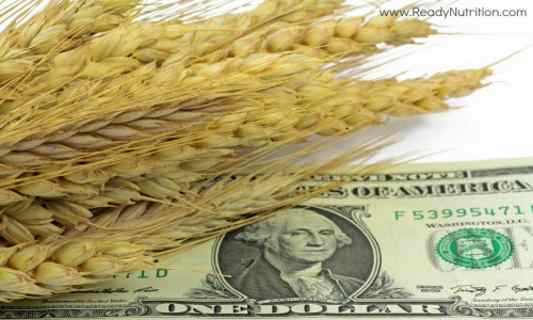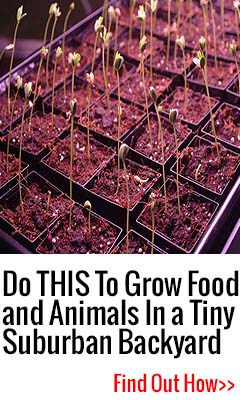End of an Era: Prospects Look Bleak for Slowing the Coming Food Crisis
By and large, the majority of the population have deluded themselves into believing a bright future is upon the horizon. For years, economic forecasters and preppers alike have warned of the bottom dropping out of the economy. You know what I’m talking about – the proverbial doom prediction of “it’s not if, but when.” But, it’s not just a phrase to add for dramatic effect, it was a call to action. It was a warning that the American dream is about to drastically change and that it’s time to prepare accordingly. Quite frankly, the “not if, but when” expression is closer than we want it to be.
The End of an Era
We have all seen the anomalous increase in food prices. We can blame it on the extreme weather patterns, or the increased cost-of-living that has occurred over several years, but there is another element to consider. While these factors certainly play into the equation, experts believe the root cause is that the world has entered into an era of “peak food” production. Peak production refers to a point at which the growth in production of a crop, animal or other foodstuff begins to slow down.
Many believe this simultaneous peaking of the world’s basic foodstuffs is largely due to the massive population boom (world population is expected to reach nine billion by 2050), which is placing an ever-greater strain on the land for housing, agriculture, business and infrastructure. Quite simply, the demand is greater than the supply. The World Bank warned of this years ago and it continues to plague our way of life. As we continue down this unsustainable path, prices in food and other goods will only continue to climb leaving many without the wherewithal to invest in healthy food choices for their family.
Eating cheaper, less nutritious food, will have catastrophic life-long effects on the social, physical, and mental well-being of millions of young people. We are already seeing this today. According to the last Census report, one out every five children is on food stamps – that’s more than before the recession. This is how many believe the powers that be will bleed the upper and middle class dry. Mac Slavo notes just how serious things have gotten for the middle class.
This chart, published by the London Telegraph, shows what has happened to Americans as they struggled to tread water and keep afloat after 2008. For the United States, there have been some signs of improvement, but mostly for those already on top. And the general decline in the global rankings of economic freedom and civil liberties does not complement the widening inequality, either.
It illustrates the dramatic shift from the post-World War II years of economic expansion to where we stand now…
Moreover, in a recent article written by Michael Snyder of the Economic Collapse Blog, he cautions that the collapse in oil will also play a leading role in the destruction of our economy.
We are really starting to see the price of oil weigh very heavily on the economy and on the stock market…
The key to how much damage this oil collapse is going to do to our economy is not how low prices ultimately go. Rather, the key is how long they stay at these low levels. If the price of oil went back to $80 a barrel next week, the damage would be fairly minimal. But if the price of oil stays at this current level for the remainder of 2015, the damage will be absolutely catastrophic.
Build Out Your Lifelines
Folks, this is the time that we have all been preparing for. The near future will be the moment your preparedness endeavors will pay off. Essentially, they will become your lifeline. Times have been good to many of us and we have had the gift of time to prepare, but now is the time to double down on your preparedness efforts. It’s time we accept that we have reached an era of total unpredictability.
Clearly there are changes that are necessary in order to slow this impending fate. One simple change we can all make is to consume the food you purchase. Roughly 30 to 40 per cent of the food grown globally for human consumption never gets eaten. Eliminating this wasteful way of life would go a long way to feeding the growing population.
Another way to circumvent this inevitability is to begin limiting our dependence on the grocery stores. Growing or raising your own food sources, learning skills to live self-reliantly, and bartering for goods and services will help you become more in tune with what your family needs to survive the food plateaus in the coming years. As well, consider these other suggestions for limiting your exposure to this potential game changer.
- Get prepared. Buying food, products and supplies in bulk, will help you prepare for price inflation. If you have the means to do so, buy 30-60 days’ worth so that you have everything you need. Having these on hand will help you if times become more difficult. You can use this free online series to begin creating a personal step-by-step preparedness plan for your family; or, buy the best-selling book, The Prepper’s Blueprint to use as a reference in your preparations.
- Preserve wealth. Choose hard assets (dry goods, precious metals, land, livestock, skills, etc.) for long term investments so they will hold their intrinsic value over time. Holding these types of investments will insulate you from inflation and other economic issues. Further, by tying your money up in assets it will help you avoid the inflating prices of food sources in the future, thus furthering your cause of self-reliant living.
- Invest in food. If we are at our peak for certain foods, now is the time to store them for future use. Further, these foods last a lifetime and would make a sound investments for future planning. Ironically, many of these are in the peak foods list. Ideally, you want to store shelf stable foods that your family normally consumes, as well as find foods that are multi-dynamic and serve many purposes. Dry goods like rice, wheat, beans, salt, honey, and dry milk will provide you with an investment that will grow in value as prices rise, and also offer you peace of mind in case the economy further degrades because you’ll be in direct possession of your food. How much food should you store? The Ready Nutrition food storage calculator can help you to determine how much inventory you may need and allows you to break your purchases into weekly shopping trips so you don’t have to invest thousands of dollars up front. As well, read Emergency Items: What Will Disappear First for more ideas.
- Invest in an emergency pantry. Did you know that nearly 23% of your grocery bill is spent on processed foods and sweets? Rather than spending it on GMO filled junk, you can use that money to invest in a food pantry. One of the best decisions my family made into our future livelihood was to eliminate our debt by simplifying our lifestyle, and by creating a food pantry based on the 25 most popular pantry goods.
- Learn how to grow your own food. In a homestead environment, a person wants the land to work for them as much as possible. Invest in fruit trees, seeds and garden supplies. If you really want these peak foods, find a way to grow them yourself. Further, if you live in a rural area, consider investing in trees and bushes that will lure wild game. The trees and bushes can provide you with added sustenance and help you stock meat in your freezer. Here is a how-to guide for creating a garden fast.
- Raise livestock. Rather than paying hard-earned money at the store for eggs, poultry and dairy – raise them yourself. Chickens are very easy to care for and can provide you with meat and eggs throughout the year. Additionally, you can find substitutions for these peak foods with a little research and ingenuity. For example, rabbits would be a suitable protein replacement. Similar to chickens, they don’t require much care and with some effort can be fed from the homestead’s garden or you cangrow fodder. They are also great breeders and will provide you with ample amounts of meat. These are the 10 best meat rabbit breeds. As well, for modestly purchasing a fishing license, you can stock your freezer with fresh-caught fish.
- It all adds up. Pay off debts ahead of time and work to restructure your outgoing funds to lower your expenses as much as possible. Any money that is saved, set it aside. That way, if your personal income dries up, you won’t have to go into default.
- Simplifying your lifestyle. Before you begin investing, take steps to get out of debt. Debt only enslaves you further, and simplifying your lifestyle can help break those shackles. Learn about these 6 ways to simplify your lifestyle.
We Have a Choice
With higher population volumes competing for the same types of foods, food inflation is a likely scenario facing an already struggling society. Malnourishment could be a the forefront of long-term issues due to this issue. As se stand at the brink of this precipice, remember that you have a choice to make. You can continue to ignore the tell-tale signs or do something about it. The investments you make into your future today can be consumed and used tomorrow. Sooner or later these essential crops could stop producing altogether and your lifelines will need to be in place.
Survival MD (Best Post Collapse First Aid Survival Guide Ever)
Backyard Innovator (A Self Sustaining Source Of Fresh Meat,Vegetables And Clean Drinking Water)
Blackout USA (EMP survival and preparedness)
Conquering the coming collapse (Financial advice and preparedness )
Liberty Generator (Build and make your own energy source)
Backyard Liberty (Easy and cheap DIY Aquaponic system to grow your organic and living food bank)
Bullet Proof Home (A Prepper’s Guide in Safeguarding a Home )
Family Self Defense (Best Self Defense Strategies For You And Your Family)
Sold Out After Crisis (Best 37 Items To Hoard For A Long Term Crisis)
SOURCE : www.thedailysheeple.com




